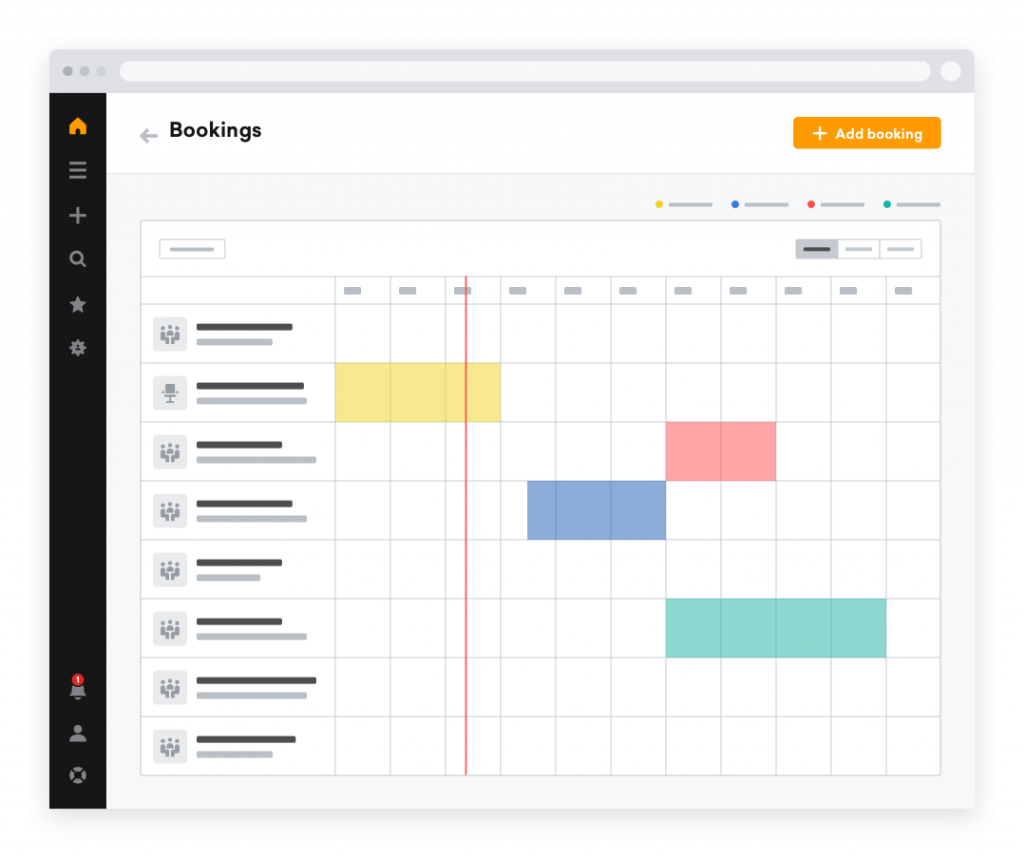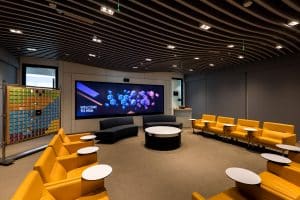Introduction
In today’s fast-paced business environment, the efficiency of office space management is paramount. As companies navigate the complexities of hybrid work models and fluctuating office attendance, the role of sophisticated meeting room reservation systems becomes increasingly crucial. These systems not only streamline the booking process but also enhance workspace utilization, ensuring that every meeting room serves its purpose without standing idle.
Meeting room reservation systems offer a plethora of functionalities that cater to diverse organizational needs:
- Seamless integration with popular office tools like Microsoft 365 and Google Workspace, making them an indispensable part of daily office operations (Skedda).
- Real-time availability updates prevent double bookings and optimize space usage.
- Mobile compatibility allows employees to make reservations on the go, fostering a dynamic and flexible work environment.
This article delves into the best meeting room reservation systems available in 2024, providing you with a detailed analysis of their features, benefits, and how they can transform your office space management. Whether you’re a small startup or a large enterprise, understanding these systems’ impact on workplace efficiency is vital for making informed decisions that promote productivity and employee satisfaction.
For more insights on the integration capabilities of these systems, visit our source.
What Are Meeting Room Reservation Systems?

Meeting room reservation systems are sophisticated digital tools designed to streamline the booking and management of meeting spaces within an organization. These systems are a cornerstone of modern office management, particularly crucial in today’s hybrid work environments where space utilization must be maximized for efficiency and productivity.
Basic Features and Functionalities
At their core, meeting room reservation systems offer:
- Real-time booking calendars that display available times and prevent double-booking.
- Automatic updates to reflect changes in room availability instantly.
- Administrative controls for managing permissions and access.
- Integration with existing organizational tools, such as email calendars and communication platforms, facilitating a seamless workflow.
Key Features to Look for in a System
When selecting a meeting room reservation system, there are several key features to consider that enhance functionality and user satisfaction:
- Booking Interface: A user-friendly interface is crucial. It should allow users to book rooms effortlessly with just a few clicks, display room availability in real-time, and provide detailed information about room features and booking restrictions.
- Integration Capabilities: The best systems offer robust integration with popular office software suites such as Microsoft 365 and Google Workspace. For example, Skedda excels in this area by seamlessly connecting with these platforms, making it a preferred choice for many organizations. This integration aids in maintaining a unified system where users can manage all aspects of their office environment from a single platform (Skedda).
- Mobile Accessibility and User Experience: With the increasing need for mobility in the workplace, a system that offers a mobile application or a mobile-responsive design is indispensable. This feature allows employees to book meeting spaces on-the-go, ensuring efficient use of office resources and adapting to the dynamic needs of modern workforces.
These features not only make the reservation process more efficient but also contribute to better space management, leading to increased productivity and reduced operational costs. For more insights into how systems like Skedda integrate with office tools.
Benefits of Implementing a Meeting Room Booking System

Implementing a meeting room booking system brings numerous benefits to any organization, ranging from better space management to enhanced employee productivity. As workplaces evolve, the need for efficient and flexible office environments becomes more apparent. Here’s how a well-integrated booking system can help:
- Improved Space Utilization: By using a meeting room booking system, companies can maximize their office layout by ensuring that all available spaces are utilized properly and not left empty unnecessarily. This leads to a reduction in wasted space and can significantly decrease overhead costs associated with underutilized areas.
- Enhanced Employee Productivity: When employees spend less time searching for available rooms and resolving scheduling conflicts, they can focus more on productive tasks. A streamlined booking process reduces friction and frustration, leading to a smoother workflow and more efficient meeting management.
Case Studies
Examples of Successful Implementations
Many companies across various industries have seen substantial benefits from implementing advanced meeting room booking systems:
- Tech Startups: A notable tech startup implemented a room reservation system and reported a 30% reduction in time spent managing meeting spaces, which directly translated into more time focused on core development tasks.
- Large Corporates: A multinational corporation introduced a meeting room booking solution that integrated with their existing digital workplace tools, resulting in a 50% decrease in booking conflicts and a noticeable boost in meeting efficiency.
Impact on Workplace Efficiency and Employee Satisfaction
The positive impacts of these systems on workplace efficiency and employee satisfaction are well-documented:
- Efficiency: With features like automatic room release and real-time updates, companies observe a smoother flow in meeting management, reducing downtime and enhancing the overall operational efficiency of the office.
- Employee Satisfaction: Employees express greater satisfaction due to the ease of use and fairness in meeting room allocations. This improvement in the workplace environment contributes to overall job satisfaction and can help in retaining talent.
For detailed insights and more in-depth case studies, businesses can explore articles and reports such as those provided by Skedda, which outline specific success stories and statistical improvements following the adoption of their systems.
Review of Top Meeting Room Reservation Systems

Selecting the right meeting room reservation system can significantly impact the efficiency and productivity of any organization. Let’s explore some of the most popular systems currently available, such as Skedda and Envoy, among others.
Skedda
- Features: Skedda offers a user-friendly interface with features like drag-and-drop booking, customizable booking conditions, and integration with calendars such as Google Calendar and Microsoft Outlook.
- Pricing: Skedda provides a tiered pricing structure, including a free version for small teams and premium options that cater to larger organizations with advanced needs.
- Pros: Highly flexible and configurable; excellent for managing different types of spaces.
- Cons: Some users report a learning curve when setting up more complex configurations.
Envoy
- Features: Envoy focuses on seamless integration with existing workplace tools, offering features like real-time availability indicators, mobile access, and environmental analytics to optimize space usage.
- Pricing: Envoy offers a free trial, with subsequent pricing based on the number of rooms and features required.
- Pros: Strong mobile platform; integrates well with other office management systems.
- Cons: Can be costly for organizations with many rooms to manage.
For more detailed comparisons and reviews of these systems, resources like Capterra provide comprehensive insights and user feedback.
How to Choose the Right System for Your Business

Choosing the right meeting room reservation system requires careful consideration of several key factors:
- Business Size: The scale of your operation will dictate the complexity of the system needed. Smaller businesses may require simpler, more cost-effective solutions, while larger enterprises might benefit from a more robust system with extensive integration capabilities.
- Specific Needs: Consider the specific needs of your organization. For example, do you need advanced features like integration with RFID for automatic check-ins, or are basic features sufficient?
- Existing IT Infrastructure: The compatibility of the reservation system with your existing IT infrastructure is crucial. Systems that can integrate seamlessly with your current software will reduce transition times and decrease the likelihood of implementation issues.
- Budget Constraints: Cost is always a consideration. Evaluate the total cost of ownership, including setup, monthly or annual fees, and any additional costs for support or extra features.
Making the right choice involves balancing these factors to find a system that offers the best combination of features, ease of use, and value for your organization. For an in-depth guide on integrating these systems with your existing infrastructure, consider exploring further resources or consulting with an IT specialist who can provide tailored advice based on your specific circumstances.
Integration and Setup

Successfully integrating and setting up a meeting room reservation system is a critical step that can determine the overall effectiveness and user adoption rate of the tool within your organization. Here’s a streamlined approach to ensure that your chosen system works seamlessly with your current infrastructure and meets your operational needs.
Step-by-Step Guide for Integration
- Initial Assessment: Begin by evaluating your current technological environment and the specific requirements of your organization. This includes understanding the hardware, software, and network settings that the new system will need to interface with.
- Choose the Right Integration Level: Depending on your existing IT infrastructure, choose whether a shallow integration (basic functionality with minimal connection to other systems) or deep integration (complete sync and interaction with other enterprise systems) is necessary.
- Technical Setup: Install any required software on servers or cloud services, configure settings to match your room types, privacy requirements, and booking rules. Ensure that the system supports mobile access if needed.
- Sync with Calendars and Email Systems: Most room booking systems offer integrations with popular calendar applications like Google Calendar, Microsoft Outlook, and others. Set these up to allow automatic syncing of meeting schedules and room availability.
- Training and Rollout: Organize training sessions for your staff to ensure they understand how to use the new system effectively. This might include hands-on demonstrations, instructional materials, and support hotlines.
- Testing: Before going live, conduct thorough testing to catch any issues with the booking process, integrations, or user interface glitches.
- Go Live and Monitor: Once you are confident with the setup and testing, launch the system to the whole organization. Monitor the system’s performance and gather feedback from users to make any necessary adjustments.
Tips for a Smooth Implementation
- Engage IT Early: Involving your IT team early in the process can help foresee potential integration challenges and prepare solutions in advance.
- Focus on User Experience: Ensure the system is intuitive and easy to use to encourage adoption by all employees.
- Plan for Scalability: Consider future growth in your company and ensure the system can scale as needed.
For more detailed guidance on integration techniques and strategies, sources like TechRepublic offer articles and how-tos that can provide additional insights and practical advice.
Proper integration and setup are not just about technical steps but also about aligning the new system with your organization’s workflow and culture. This approach helps ensure that the meeting room booking system will be a valuable tool for managing your workplace more efficiently.
Conclusion
As we’ve explored in this article, the landscape of meeting room reservation systems is dynamic and increasingly influenced by technological advancements. From AI-enhanced functionalities that predict and adjust to your meeting needs, to IoT integrations that optimize room conditions automatically, these systems are not just about booking a space—they’re about creating an environment that enhances productivity and efficiency.
The integration of these technologies helps organizations not only save time and resources but also supports a more flexible and responsive workplace culture. Moreover, as remote work arrangements continue to be prevalent, the importance of integrating virtual and augmented reality to provide seamless remote participation will likely become a standard feature in future systems.
Adopting and adapting to these systems is not merely a matter of keeping up with technology—it’s about actively reshaping the workplace to foster better collaboration, greater efficiency, and ultimately, higher employee satisfaction. Organizations looking to stay ahead must consider these factors and choose solutions that are scalable, secure, and user-friendly.
For those interested in further reading, resources such as TechCrunch often provide valuable insights into the latest technological trends and innovations in workplace management systems, offering a glimpse into the future of office environments.
In conclusion, as meeting room reservation systems evolve, they promise to play a pivotal role in the transformation of workspaces into more efficient, enjoyable, and productive environments. To explore cutting-edge booking solutions that could transform your workspace, consider checking out SpotBooker, where the latest technology meets user-friendly design to streamline your meeting management process.






